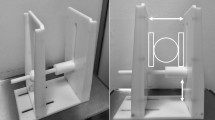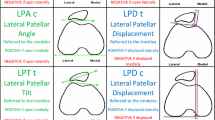Abstract
Purpose
To present a semi-automatic method with minimal user interaction for quantitative analysis of the patellofemoral motion pattern.
Methods
4D CT data capturing the patellofemoral motion pattern of a continuous flexion and extension were collected for five patients prone to patellar luxation both pre- and post-surgically. For the proposed method, an observer would place landmarks in a single 3D volume, which then are automatically propagated to the other volumes in a time sequence. From the landmarks in each volume, the measures patellar displacement, patellar tilt and angle between femur and tibia were computed.
Results
Evaluation of the observer variability showed the proposed semi-automatic method to be favorable over a fully manual counterpart, with an observer variability of approximately 1.5\(^{\circ }\) for the angle between femur and tibia, 1.5 mm for the patellar displacement, and 4.0\(^{\circ }\)–5.0\(^{\circ }\) for the patellar tilt. The proposed method showed that surgery reduced the patellar displacement and tilt at maximum extension with approximately 10–15 mm and 15\(^{\circ }\)–20\(^{\circ }\) for three patients but with less evident differences for two of the patients.
Conclusions
A semi-automatic method suitable for quantification of the patellofemoral motion pattern as captured by 4D CT data has been presented. Its observer variability is on par with that of other methods but with the distinct advantage to support continuous motions during the image acquisition.








Similar content being viewed by others
References
Alta TD, Bell SN, Troupis JM, Coghlan JA, Miller D (2012) The new 4-dimensional computed tomographic scanner allows dynamic visualization and measurement of normal acromioclavicular joint motion in an unloaded and loaded condition. J Comput Assist Tomogr 36(6):749–754
Buckens CF, Saris DB (2010) Reconstruction of the medial patellofemoral ligament for treatment of patellofemoral instability a systematic review. Am J Sports Med 38(1):181–188
Bull A, Katchburian M, Shih Y, Amis A (2002) Standardisation of the description of patellofemoral motion and comparison between different techniques. Knee Surg Sports Traumatol Arthrosc 10(3):184–193
Dejour H, Walch G, Nove-Josserand L, Guier C (1994) Factors of patellar instability: an anatomic radiographic study. Knee Surg Sports Traumatol Arthrosc 2(1):19–26
de Sá Rebelo M, Moreno RA, Gobbi RG, Camanho GL, de Ávila LFR, Demange MK, Pecora JR, Gutierrez MA (2014) Description of patellar movement by 3D parameters obtained from dynamic CT acquisition. In: Proceedings of the SPIE, vol 9035, p 903538
Draper CE, Besier TF, Fredericson M, Santos JM, Beaupre GS, Delp SL, Gold GE (2011) Differences in patellofemoral kinematics between weight-bearing and non-weight-bearing conditions in patients with patellofemoral pain. J Orthop Res 29(3):312–317
Earhart C, Patel DB, White EA, Gottsegen CJ, Forrester DM, Matcuk GR Jr (2013) Transient lateral patellar dislocation: review of imaging findings, patellofemoral anatomy, and treatment options. Emerg Radiol 20(1):11–23
Galland O, Walch G, Dejour H, Carret J (1990) An anatomical and radiological study of the femoropatellar articulation. Surg Radiol Anat 12(2):119–125
Granlund G, Knutsson H (eds) (1995) Signal processing for computer vision. Kluwer, Dordrecht
Jerbi T, Burdin V, Leboucher J, Stindel E, Roux C (2013) 2-D–3-D frequency registration using a low-dose radiographic system for knee motion estimation. IEEE Trans Biomed Eng 60(3):813–820
Kang Y, Engelke K, Kalender WA (2003) A new accurate and precise 3-D segmentation method for skeletal structures in volumetric CT data. IEEE Trans Med Imaging 22(5):586–598
Kim Y, Kim D (2009) A fully automatic vertebra segmentation method using 3D deformable fences. Comput Med Imaging Graph 33(5):343–352
Laurin C, Dussault R, Levesque H (1979) The tangential X-ray investigation of the patellofemoral joint: X-ray technique, diagnostic criteria and their interpretation. Clin Orthop Relat Res 144:16–26
Lerner AL, Tamez-Pena JG, Houck JR, Yao J, Harmon HL, Salo AD, Totterman SM (2003) The use of sequential MR image sets for determining tibiofemoral motion: reliability of coordinate systems and accuracy of motion tracking algorithm. J Biomech Eng 125(2):246–253
Mulford J, Wakeley C, Eldridge J (2007) Assessment and management of chronic patellofemoral instability. J Bone Joint Surg Br 89(6):709–716
Ohnishi T, Suzuki M, Nawata A, Naomoto S, Iwasaki T, Haneishi H (2010) Three-dimensional motion study of femur, tibia, and patella at the knee joint from bi-plane fluoroscopy and CT images. Radiol Phys Technol 3(2):151–158
Rebelo MA, Moreno RA, Gobbi RG, Camanho GL, Avila LF, Demange MK, Pecora JR, Gutierrez MA (2014) Estimation of 3D biomechanics parameters of patellar movement using dynamic CT images. In: 5th IEEE RAS and EMBS international conference on biomedical robotics and biomechatronics. IEEE, pp 102–107
Schöttle P, Fucentese S, Romero J (2005) Clinical and radiological outcome of medial patellofemoral ligament reconstruction with a semitendinosus autograft for patella instability. Knee Surg Sports Traumatol Arthrosc 13(7):516–521
Selvik G (1989) Roentgen stereophotogrammetry: a method for the study of the kinematics of the skeletal system. Acta Orthop 60(S232):1–51
Sillanpää PJ, Mattila VM, Visuri T, Mäenpää H, Pihlajamäki H (2011) Patellofemoral osteoarthritis in patients with operative treatment for patellar dislocation: a magnetic resonance-based analysis. Knee Surg Sports Traumatol Arthrosc 19(2):230–235
Smith TO, Song F, Donell ST, Hing CB (2011) Operative versus non-operative management of patellar dislocation: a meta-analysis. Knee Surg Sports Traumatol Arthrosc 19(6):988–998
Smith TO, Donell S, Song F, Hing CB (2015) Surgical versus nonsurgical interventions for treating patellar dislocation. Cochrane Database Syst Rev (2). doi:10.1002/14651858.CD008106.pub3
Souza RB, Draper CE, Fredericson M, Powers CM (2010) Femur rotation and patellofemoral joint kinematics: a weight-bearing magnetic resonance imaging analysis. J Orthop Sports Phys Ther 40(5):277–285
Truc PT, Kim TS, Lee S, Lee YK (2010) A study on the feasibility of active contours on automatic CT bone segmentation. J Digit Imaging 23(6):793–805
Van Kampen A, Huiskes R (1990) The three-dimensional tracking pattern of the human patella. J Orthop Res 8(3):372–382
von Eisenhart-Rothe R, Siebert M, Bringmann C, Vogl T, Englmeier KH, Graichen H (2004) A new in vivo technique for determination of 3D kinematics and contact areas of the patello-femoral and tibio-femoral joint. J Biomech 37(6):927–934
Wu D, Sofka M, Birkbeck N, Zhou S (2014) Segmentation of multiple knee bones from CT for orthopedic knee surgery planning. In: Medical image computing and computer-assisted intervention (MICCAI 2014). Lecture Notes in Computer Science, vol 8673. Springer, Berlin, pp 372–380
Acknowledgments
Visualization and measurements were performed using MeVisLab (provided by Fraunhofer MEVIS, Bremen).
Funding D. Forsberg has been partly funded VINNOVA, the Swedish Innovation Agency (Grant 2014-01422).
Author information
Authors and Affiliations
Corresponding author
Ethics declarations
Conflict of interest
D. Forsberg is an employee of Sectra AB, a medical IT provider for radiology and pre-operative planning within orthopedics. The other authors declare that they have no conflict of interest.
Ethical approval
All procedures performed in studies involving human participants were in accordance with the ethical standards of the institutional and/or national research committee and with the 1964 Helsinki declaration and its later amendments or comparable ethical standards.
Informed consent
Informed consent was obtained from all individual participants included in the study.
Rights and permissions
About this article
Cite this article
Forsberg, D., Lindblom, M., Quick, P. et al. Quantitative analysis of the patellofemoral motion pattern using semi-automatic processing of 4D CT data. Int J CARS 11, 1731–1741 (2016). https://doi.org/10.1007/s11548-016-1357-8
Received:
Accepted:
Published:
Issue Date:
DOI: https://doi.org/10.1007/s11548-016-1357-8




